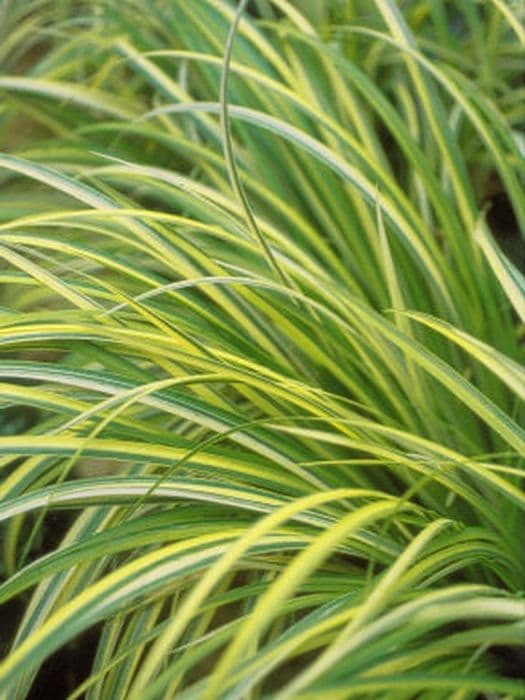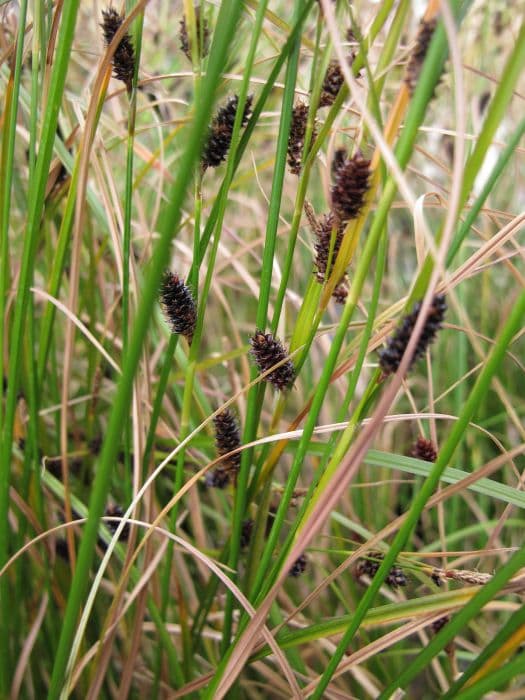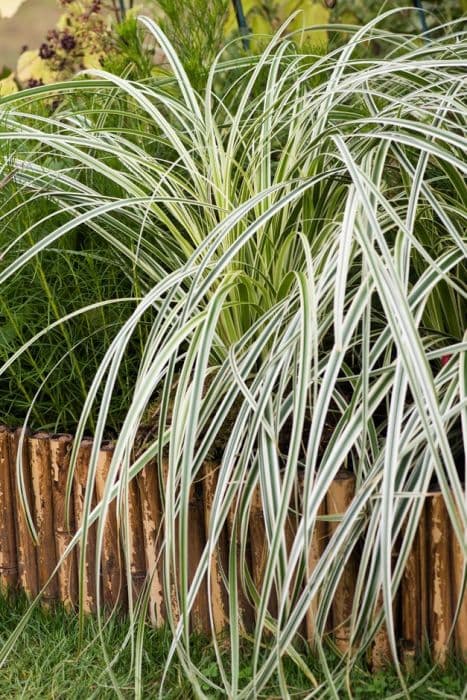Evergold Sedge Carex oshimensis 'Evergold' (v)

ABOUT
The plant commonly known as 'Evergold' sedge is a striking ornamental grass known for its beautiful foliage. It features a creamy-yellow stripe that runs down the center of each dark green leaf, creating a bold contrast that makes it stand out in garden settings. The leaves are narrow and arching, forming a dense, tufted mound that gracefully spills in all directions. The color combination of the yellow and green gives it a bright and variegated appearance, which remains visually appealing across the seasons. The edges of the 'Evergold' sedge are finely textured, giving it a delicate look despite its hardy nature. This plant produces very small, inconspicuous flowers that generally do not draw much attention compared to the striking variegated foliage. Its appearance adds a touch of elegance and visual interest to garden beds, borders, or when planted in mass as a ground cover. The 'Evergold' sedge also looks attractive in container plantings, where its foliage can drape over the edges for a soft, lush appearance.
About this plant
 Names
NamesSynonyms
Oshima Sedge, Evergold Sedge, Variegated Japanese Sedge, Gold Sedge.
Common names
Carex oshimensis 'Evergold'
 Toxicity
ToxicityTo humans
The sedge 'Evergold' is not known to be toxic to humans. While it is not a plant intended for consumption, it generally doesn't cause harm if touched or accidentally ingested in small quantities. However, as with any plant, individual allergic reactions are possible, so it is always prudent to handle plants with care and wash hands after gardening. If any part of the plant is ingested and negative symptoms occur, it is important to seek medical advice.
To pets
The sedge 'Evergold' is generally considered non-toxic to pets. It should not cause poisoning if pets happen to ingest small amounts. Nevertheless, ingestion of non-food plants can occasionally result in gastrointestinal upset for animals, such as vomiting or diarrhea. It's always a good practice to prevent pets from eating ornamental plants as a precautionary measure and consult a veterinarian if any unusual symptoms appear after ingestion.
 Characteristics
CharacteristicsLife cycle
Perennials
Foliage type
Evergreen
Color of leaves
Variegated
Height
1 feet 6 inches (45 cm)
Spread
1 feet 6 inches (45 cm)
Plant type
Herb
Hardiness zones
5
Native area
Japan
Benefits
 General Benefits
General Benefits- Attractive Foliage: 'Evergold' sedge has striking variegated leaves that provide year-round visual interest.
- Low Maintenance: This plant is easy to care for, requiring minimal pruning and upkeep to maintain its appearance.
- Drought Tolerant: Once established, it can tolerate periods of dryness, making it suitable for gardens with less water availability.
- Shade Tolerance: It can thrive in partially shaded areas where other plants might struggle to grow.
- Pest Resistance: Generally resistant to pests, reducing the need for chemical treatments in the garden.
- Dense Growth: Its clumping habit can help suppress weeds, minimizing the need for frequent weeding.
- Soil Stabilization: The root system helps stabilize the soil, which can prevent erosion in sloped or unstable areas.
- Deer Resistance: It is generally not a preferred plant for deer to eat, so it's more likely to remain untouched in areas with deer pressure.
- Winter Interest: The foliage often remains attractive in winter, providing color and texture during the colder months.
- Versatile Landscaping: Suitable for a variety of landscaping uses, including borders, ground covers, and container gardening.
 Medical Properties
Medical PropertiesThis plant is not used for medical purposes.
 Air-purifying Qualities
Air-purifying QualitiesThis plant is not specifically known for air purifying qualities.
 Other Uses
Other Uses- Carex oshimensis 'Evergold' can be utilized as a living mulch in garden beds to suppress weeds and help retain soil moisture given its dense foliage.
- This sedge variety can serve as erosion control on slopes and banks because its root systems help stabilize the soil.
- Evergold is often used in container gardens, providing a spiky texture and contrasting foliage to complement flowering plants or other foliage shapes.
- It can be used in cut flower arrangements, where the variegated leaves add a different dimension and texture to the floral design.
- This plant is also suitable for crafting, where the leaves can be woven or braided into small decorative items like wreaths or baskets due to their durability.
- Evergold can be incorporated into rain gardens, that are designed to withstand temporary flooding and help in water filtration.
- In winter gardens, Carex oshimensis 'Evergold' provides much-needed color and texture when most other plants have died back.
- It can be used as a natural divider or border in gardens or walkways without the need for hardscaping materials.
- Evergold plants can be used in sensory gardens as their leaves have a distinctive texture that can be appreciated by touch.
- Because of its compact size and ornamental appeal, Carex oshimensis 'Evergold' is suitable for planting in graveyards and memorial gardens where low maintenance and respect for the site are primary concerns.
Interesting Facts
 Feng Shui
Feng ShuiThe Japanese Sedge is not used in Feng Shui practice.
 Zodiac Sign Compitability
Zodiac Sign CompitabilityThe Japanese Sedge is not used in astrology practice.
 Plant Symbolism
Plant Symbolism- Resilience: As an evergreen perennial, the Evergold Sedge represents resilience and the ability to withstand various conditions throughout the seasons.
- Adaptability: This plant's versatility in different garden settings symbolizes adaptability and flexibility in life's situations.
- Reliability: The consistent variegated foliage of the Evergold Sedge makes it a symbol of dependability and steadfastness.
- Natural beauty: With its striking leaf patterns, Evergold Sedge is often associated with natural beauty and simplicity.
 Water
WaterThe Japanese Sedge 'Evergold' should be watered thoroughly, allowing the soil to be moist but not waterlogged. It prefers consistent moisture and should not be allowed to dry out completely. Water the plant approximately once a week, adjusting frequency based on weather conditions and soil drainage. During the growing season, you may need to increase watering to maintain the soil moisture. A general guideline is to provide about 1 to 1.5 gallons of water per week, depending on the plant's size and the environmental conditions.
 Light
LightJapanese Sedge 'Evergold' thrives best in partial shade to full shade. It can tolerate some morning sun, but too much direct sunlight may scorch the leaves, so a spot with dappled sunlight or a location that receives shade in the afternoon is ideal for this plant. Avoid placing it in a location where it will receive harsh midday or afternoon sun to maintain the vibrant variegation of its foliage.
 Temperature
TemperatureThe Japanese Sedge 'Evergold' can tolerate a range of temperatures but thrives in conditions between 60 to 75 degrees Fahrenheit. It can survive minimum temperatures down to about 20 degrees Fahrenheit and maximum temperatures up to around 85 degrees Fahrenheit. The ideal temperature conditions are in the range of 60 to 75 degrees Fahrenheit to promote healthy growth and maintain foliage color.
 Pruning
PruningPruning Japanese Sedge 'Evergold' is primarily done to remove any brown or damaged leaves and to maintain its tidy appearance. Lightly comb through the foliage with your fingers or a rake to remove dead material, doing so in early spring before new growth begins. Pruning can be done annually or as needed to keep the plant looking fresh and vibrant. The best time for pruning is early spring, as the plant emerges from dormancy.
 Cleaning
CleaningAs needed
 Soil
SoilThe best soil mix for Japanese Sedge 'Evergold' should be well-draining, consisting of a blend of loam, sand, and peat to maintain moisture without becoming waterlogged. Ideal soil pH for this plant is slightly acidic to neutral, ranging from 5.5 to 7.
 Repotting
RepottingJapanese Sedge 'Evergold' generally does not require frequent repotting as it prefers to be somewhat root-bound. Repot every 2-3 years or when the plant visibly outgrows its pot.
 Humidity & Misting
Humidity & MistingJapanese Sedge 'Evergold' thrives best in moderate humidity levels; however, it can tolerate a range of humidity conditions as long as the soil moisture is maintained appropriately.
 Suitable locations
Suitable locationsIndoor
Place in bright, indirect light and keep soil moist.
Outdoor
Plant in partial shade and well-draining soil.
Hardiness zone
5-9 USDA
 Life cycle
Life cycleCarex oshimensis 'Evergold', commonly known as Evergold sedge, begins its life as a seed which, when conditions are favorable, germinates in moist, well-draining soil. As a perennial, it enters a growth phase each spring, developing long, variegated leaves that form a dense, fountain-like clump. During the growing season, it may produce small, inconspicuous flowers, followed by seed-bearing spikes, although this plant is primarily grown for its foliage. Evergold sedge is a cool-season grass, so it actively grows during the spring and autumn while slowing down in the heat of summer. In the winter, growth ceases, and the plant goes dormant, but it is evergreen, retaining its leaves year-round in milder climates. As a perennial, it will re-emerge from its root system the following spring, repeating its life cycle.
 Propogation
PropogationPropogation time
Spring-Early Summer
The sedge known as Carex oshimensis 'Evergold', commonly referred to as Evergold sedge, is typically propagated through division. The ideal time to carry out this process is in the early spring or late fall when the plant is not in active growth. To propagate the Evergold sedge by division, carefully dig up the plant and gently pull apart the clumps into smaller sections, ensuring that each section has a portion of roots attached. These divisions can then be replanted in the ground or into pots at the same depth they were originally growing. It's important to water the new divisions thoroughly after planting to help establish them. This method of propagation allows the gardener to create new plants that are genetically identical to the parent plant, maintaining the variegated foliage pattern that 'Evergold' is known for.









